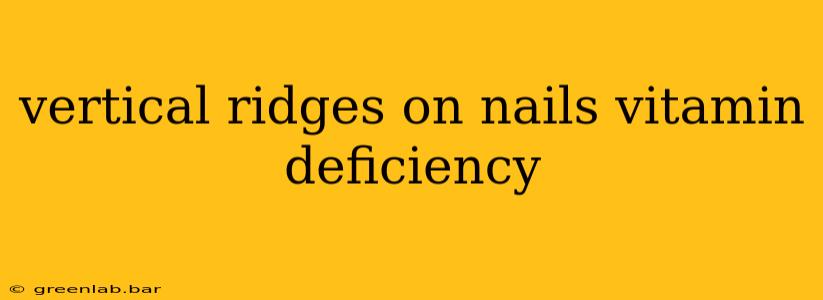Vertical ridges, those thin, indented lines running from the cuticle to the tip of your fingernail, are a common nail condition affecting people of all ages. While often harmless, they can sometimes indicate underlying health issues, including potential vitamin deficiencies. This comprehensive guide delves into the various causes of vertical nail ridges, focusing specifically on the role of nutritional deficiencies and how to address them.
What Causes Vertical Ridges on Nails?
The appearance of vertical ridges on nails is multifaceted, with several factors contributing to their development. These include:
- Aging: As we age, our nails naturally become thinner and more prone to developing ridges. This is a completely normal part of the aging process.
- Trauma: Injury to the nail matrix (the area under the cuticle where nail growth originates) can lead to the formation of ridges. This can be from a minor bump or a more significant injury.
- Underlying Medical Conditions: Certain medical conditions, such as eczema, psoriasis, and alopecia areata, can be associated with nail changes, including vertical ridging. Conditions affecting blood circulation can also manifest as nail changes.
- Genetics: A family history of nail ridges can increase your susceptibility.
- Dehydration: Severe dehydration can affect nail health, potentially contributing to ridge formation.
- Vitamin Deficiencies: While less common than other causes, specific vitamin deficiencies can contribute to vertical nail ridging.
Vitamin Deficiencies Linked to Vertical Nail Ridges
While vertical ridges aren't solely a symptom of vitamin deficiency, certain nutrient imbalances might exacerbate their appearance or contribute to their development. The most frequently implicated vitamins are:
- Vitamin B12: A deficiency in Vitamin B12 can lead to various health problems, including changes in nail appearance. B12 is crucial for red blood cell formation and nerve function. Symptoms of B12 deficiency extend beyond nail changes and can include fatigue, weakness, and neurological issues.
- Biotin (Vitamin B7): Biotin plays a vital role in maintaining healthy hair, skin, and nails. A biotin deficiency can manifest as brittle nails, thinning hair, and skin rashes. While severe biotin deficiency is rare, mild deficiencies can subtly affect nail health.
- Vitamin C: Vitamin C is an essential antioxidant that plays a critical role in collagen production, a key component of nail structure. A severe Vitamin C deficiency (scurvy) leads to various symptoms, including fragile nails and bleeding gums.
Distinguishing Between Harmless and Concerning Ridges
Most vertical nail ridges are benign and simply a cosmetic concern. However, if the ridges are accompanied by other symptoms, such as:
- Significant changes in nail color or texture: Discoloration, thickening, or thinning of the nails.
- Pain or inflammation around the nail: Tenderness or swelling associated with the nail.
- Other symptoms of nutritional deficiency: Fatigue, weakness, hair loss, or skin problems.
- Sudden onset of ridges: If the ridges appear suddenly without any known cause.
It's crucial to consult a doctor or dermatologist. They can accurately diagnose the underlying cause and recommend appropriate treatment.
Improving Nail Health Through Diet and Lifestyle
Maintaining a balanced diet rich in vitamins and minerals is essential for healthy nails. Consider incorporating foods rich in:
- Vitamin B12: Meat, poultry, fish, eggs, dairy products, and fortified cereals.
- Biotin: Eggs, nuts, seeds, sweet potatoes, and bananas.
- Vitamin C: Citrus fruits, berries, bell peppers, and leafy green vegetables.
In addition to diet, staying adequately hydrated and managing stress can positively impact overall health, including nail health.
When to See a Doctor
While many cases of vertical nail ridges are harmless, seeking professional medical advice is crucial if you notice:
- Rapid onset of new ridges accompanied by other symptoms
- Significant changes in nail color or texture
- Pain or inflammation around your nails
- Persistent or worsening ridges despite dietary changes
This information is for general knowledge and does not constitute medical advice. Always consult a healthcare professional for any concerns regarding your health or nail condition. They can accurately assess your situation and recommend appropriate treatment.

